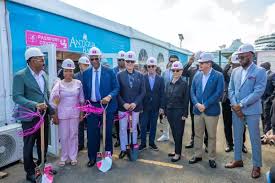St. John’s, Antigua and Barbuda — The government of Antigua and Barbuda broke ground Monday on a $40 million cruise port expansion, a transformative project poised to redefine the nation’s tourism landscape and cement its status as a premier Caribbean destination. The ambitious Upland Development Project, spearheaded by Global Ports Holding (GPH), promises to deliver state-of-the-art facilities, generate hundreds of jobs, and attract over 1.5 million cruise passengers annually by 2030.
A Vision for Growth: Port Upgrades and Economic Surge
The Antigua Cruise Port expansion will feature a 6,000-square-foot homeporting terminal, retail spaces for 100 local entrepreneurs, and a waterfront day club with pools, a swim-up bar, and entertainment venues. Additional amenities include bazaars, souvenir shops, ice cream parlors, and restaurants offering indoor and outdoor seating. Designed to seamlessly integrate with downtown St. John’s, the project aims to create a vibrant hub celebrating local culture while catering to international tourists.
“This is more than infrastructure—it’s a catalyst for prosperity,” said Prime Minister Gaston Browne at the groundbreaking ceremony. He emphasized the project’s alignment with national economic policies, noting it has already facilitated the clearance of a $30 million loan and funded a fifth berth to accommodate massive Oasis-class ships.
Jobs and Visitor Surge: By the Numbers
- 200 construction jobs during development, with 200–300 permanent positions post-completion.
- 409 cruise ship calls booked for 2025, bringing an estimated 752,426 visitors.
- Projections of 900,000 passengers in 2025 from 466 ship calls, with peaks of 300,000 visitors in January and February alone.
GPH Chairman Mehmet Kutman outlined bold growth targets: “We will reach 1.5 million passengers within five years,” he declared, underscoring commitments to local hiring and partnerships with Antiguan businesses.
Strategic Timing and Regional Competition
Scheduled for completion in early 2026, the expansion positions Antigua to capitalize on the booming cruise industry. The upgraded port will rival regional heavyweights like Barbados and the Bahamas, offering faster disembarkation, enhanced passenger experiences, and improved revenue streams for local vendors.
“This isn’t just about bigger ships—it’s about creating shared value,” said Antigua Cruise Port CEO Daren Henry, highlighting plans to connect new facilities with downtown markets. Tourism Minister Charles Fernandez added that the port will serve as a “gateway for cultural exchange,” with retail spaces prioritizing Antiguan artisans and entrepreneurs.
Challenges and Opportunities
While the project has sparked optimism, critics urge transparency in hiring and revenue-sharing models. Prime Minister Browne assured that “local labor and businesses will be prioritized at every phase,” with training programs to equip workers for hospitality and managerial roles.
The expansion also aims to reduce seasonal tourism volatility by attracting year-round visitors. “We’re not just building a port—we’re building resilience,” Fernandez said.
Looking Ahead
As bulldozers reshape Antigua’s coastline, the nation eyes a future where tourism drives sustainable development. With its blend of economic ambition and cultural pride, the project reflects a broader Caribbean trend: investing in infrastructure to compete in a post-pandemic travel boom.
The Carib Sentinel will continue to track developments in Antigua and Barbuda’s tourism sector. Follow for updates on infrastructure projects and regional economic trends.



